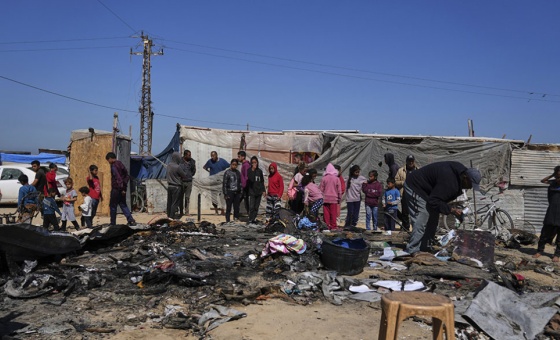This is the last article you can read this month
You can read more article this month
You can read more articles this month
Sorry your limit is up for this month
Reset on:
Please help support the Morning Star by subscribing here
IF the world turned upside down by recent events — encompassing the never-ending wars of imperialism, the 2008 financial crash, Labour’s complete degeneration and the cataclysmic split in the US ruling class — has taught us one thing it is that elaborate programmatic schemes inevitably come to grief on the rocks of a reality that is impossible to predict with any certainty.
In the Manifesto of the Communist Party drawn up in 1848 for the First International, its authors argued that the formulation “Workers of all lands unite” should replace the motto adopted by the utopian League of the Just: “All men are brothers.”
This recognised that in the actually existing capitalist society, every moral and political issue means something different to different classes.
For the capitalist employer, the flow of migrant labour is valuable in as far as it depresses the price labour power can command. For the capitalist state, the existence of a large pool of foreign skilled and trained workers that can be drawn on represents state expenditure that is not required for training and education.
For workers concerned for their own economic security in an economic system structured to deny them that very thing, the arrival of competitors for jobs can only be seen as a threat.
It is around such facts of life under capitalism that reactionaries like the leaders of Reform UK, Germany’s AfD and Le Pen’s Rassemblement National cast their message around the supposed facts of immigration.
To the extent that their Tory rivals and Keir Starmer’s Labour in government outbid Reform UK in promoting this racist narrative, the working-class movement has a problem. This was identified by Lenin when, in the moments before the Russian Revolution, he observed that revolutionaries fish in the same waters as the anti-semitic Black Hundreds then mobilised by the reactionary tsarist regime.
Britain’s nearest colonial possession was the source of an early wave of migration. Engels observed in his 1845 Condition of the Working Class in England:
“The rapid extension of English industry could not have taken place if England had not possessed in the numerous and impoverished population of Ireland a reserve at command. The Irish had nothing to lose at home, and much to gain in England; and from the time when it became known in Ireland that the east side of St George’s Channel offered steady work and good pay for strong arms, every year has brought armies of the Irish hither.
“It has been calculated that more than a million have already immigrated, and not far from 50 thousand still come every year, nearly all of who enter the industrial districts, especially the great cities, and there form the lowest class of the population.”
With an unsentimental eye, Engels described the privations and humiliation that years of colonial oppression at home and brutal exploitation in the metropolis heaped upon the expatriate Irish.
He identified the colonial policy to expel the Irish from the land as the driver of Irish emigration and observed: “Every industrial and commercial centre in England now possesses a working class divided into two hostile camps, English proletarians and Irish proletarians.
“The ordinary English worker hates the Irish worker as a competitor who lowers his standard of life. In relation to the Irish worker he regards himself as a member of the ruling nation and consequently he becomes a tool of the English aristocrats and capitalists against Ireland, thus strengthening their domination over himself. He cherishes religious, social, and national prejudices against the Irish worker.
“His attitude towards him is much the same as that of the ‘poor whites’ to the Negroes in the former slave states of the USA. The Irishman pays him back with interest in his own money. He sees in the English worker both the accomplice and the stupid tool of the English rulers in Ireland.”
Variations of this formula work out in relation to every group of expatriate colonial subjects Britain has recruited to satisfy its labour market demands. People from the Caribbean, Africa, and the Indian sub-continent have more recently been joined by Eastern Europeans made jobless by the reimposition of the dictatorship of capital; and made part of the mobile labour force by the EU’s “freedom” of movement.
According to the UN Population Fund (UNFPA), all but one of the world’s 10 fastest-shrinking countries are in central and eastern Europe. Latvia lost nearly 30 per cent of its population after its socialist economy was dismantled and is set to lose 23.5 per cent more.
Capitalist globalisation of the labour market means that some economies — the Philippines comes to mind — are now dependent on remittances from a specially created surplus of particularly skilled workers. Thus every British hospital has a contingent of Filipino nurses.
And, of course, migrant workers, especially those whose work visas tie them to a particular employer, are vulnerable. When my local hospital board failed to meet the threshold in a recent strike ballot I was told that many foreign nurses are afraid to join the union.
And the arrival of people to Britain is a complex phenomenon ranging from the reciprocal movement of highly skilled and well-remunerated professionals; employer-driven direct recruitment across the skills range, including a relatively small number of “small boat” arrivals to a significant measure of forced labour.
In its evidence to the parliamentary joint committee on human rights, the Joint Council for the Welfare of Immigrants said: “In Britain, women, men and children appear to be trafficked for labour exploitation in domestic service, agriculture, construction, catering, food processing, textile, and even in healthcare and contract cleaning, particularly in sectors with lengthy subcontracting chains.”
According to a survey in 2023, 37 per cent think immigration should be reduced a lot, 15 per cent a little, 22 per cent are ambivalent, 23 per cent think it is good, 8 per cent very good and 6 per cent don’t know.
Opinion appears to be remarkably fluid. In 1994, when this kind of data first started to be collected under 5 per cent thought immigration was a concern. Immediately before the EU referendum in June 2015 more than half named immigration the most salient issue. Three years later it was down to 20 per cent.
The dogs in the street know that it is the dog-whistle rhetoric of racist politicians on the make that is as important as actual migrant numbers in conditioning the politics around immigration.
But this is an arena where the left has to make its voice heard by the mass of working people and amid a cacophony of lies and disinformation.
Millions of workers must be convinced that where immigration appears as a problem, the solution lies not in treating the migrant as the problem but that winning better conditions for the actual migrant workers among us is the best basis for dealing with the employer in each case and with the employers as a class.
This is a difficult battle and a prolonged one but one that must be undertaken directly in our communities and in the workplace.
It needs to be carried out alongside an unrelenting offensive against the malign forces on the right, and in a way that distinguishes our opposition to the use of immigration and the discriminatory panoply of rules devised by the employing class.
Opinion is, as the figures above suggest, very fluid and this very fluidity means that workers hold contradictory opinions and are moved by contradictory factors in their experience.
Some experience has been accumulated in Germany, where the main left-wing formation, Die Linke, split over both attitudes to the Ukraine war and how to respond to the widespread opposition to the policy of the German ruling class, as personified by Chancellor Angela Merkel, of encouraging large-scale immigration, especially of well-skilled and professional people fleeing imperialism’s proxy wars.
Unlike Britain and France where migrants were originally drawn mostly from colonial possessions, migration into Germany, which was forced to surrender its colonies after the first world war, has largely been drawn from states that had ties with imperial and Nazi Germany — Turkey, Croatia, Kosovo — and parts of the Arab world where German capital traditionally had ambitions.
Die Linke’s increasingly liberal leadership rowed in behind the Nato line on the Ukraine conflict and thus lost touch with a big part of its East German constituency where anti-war sentiment is fused, for a large number of workers, with opposition to the government’s economic and immigration policies.
It was quickly eclipsed when a group of its Bundestag deputies formed the Bundis Sahra Wagenknecht (BSW) to give a voice to an anti-war sentiment that also animated many AfD voters. In the recent election, BSW came unstuck when its language around immigration, security and the welfare state allowed the dominant media to bracket it with the extreme right AfD, even though its programme had strongly anti-racist and internationalist elements.
Where its message was ambiguous and diffused it failed to cut through, leaving it exposed where its lack of an active membership base limited its reach.
The electoral base of the left is now reconfigured with Die Linke weaker in the East and among workers, but stronger in the West and among students and professionals.
Between them, Die Linke (8.8 per cent) and BSW (4.97 per cent) command much the same proportion of voters as at their height but their capacity to deal with the full range of reactionary issues that Germany’s particular crisis engenders is weakened by disunity on the peace question and the failure to infuse its messaging on migration with an anti-imperialist and anti-racist spirit.
Nick Wright blogs at 21centurymanifesto.wordpress.com.







